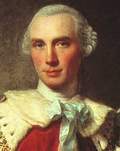 |
John Stuartb. 25 May 1713, Edinburgh, Scotland |
| Title: | First Lord Commissioner of the Treasury |
| Term: | 28 May 1762 - 15 Apr 1763 |
| 28 May 1762, appointed by the letters patent [1] | |
| 8 Apr 1763, resigned office [2, p. 31] | |
| 15 Apr 1763, not listed among new commissioners of the Treasury in the letters patent dated 15 Apr 1763 [3] | Names/titles: | 3rd Earl of Bute [from 28 Jan 1723]; Viscount Kingarth, Lord Mount Stuart, Cumrae, and Inchmarnock |
| Biography: | |
The first Scottish-born British Prime Minister — and the first Tory to hold that office — John Stuart was the eldest son of the 2nd Earl of Bute, whom he succeeded in 1723. He attended Eton and later received a degree in civil and public law from the University of Leiden. He sat in the House of Lords as an elected Scottish representative peer (1738-1741, 1761-1780). When he became tutor (1755) to the future George III, it proved to be the foundation of his political career. After the accession of George III Bute was appointed Secretary of State for the Northern Department (25 Mar 1761 - 27 May 1762) [4]. In May 1762, he was appointed First Lord of the Treasury in succession to the Duke of Newcastle and became and Leader of the House of Lords (1762-1763). During his brief administration, Bute obtained parliamentary approval (9 Dec 1762) for the preliminary treaty with France. The definitive Treaty of Paris (10 Feb 1763) ended the Seven Years' War and confirmed Great Britain's expanded colonial possessions in Canada, the West Indies, and India. He then resigned from office as he had promised when appointed. However, he continued to interfere in the affairs of his successor, George Grenville, and to act as George III's advisor, although he failed to have Grenville ousted. The King's removal in 1765 of Bute's brother from a Scottish office at Grenville's instigation ended Bute's royal advisory role. Biography sources: [2, pp. 28-32] |
|
| | |
| [1] | The letters patent issued in the names of Earl of Bute, Sir F. Dashwood, Lord North, J. Oswald and Sir J. Turner as lords commissioners of the Treasury found in Public Records Office (Patent Rolls, C 66/3684) bears the date of 28 May 1762 [6]). "Annual Register" reads: "29th. The king was pleased to appoint the right hon. John earl of Bute, first lord of the Treasury." |
| [2] | Englefield, Dermot; Seaton, Janet; White, Isobel (eds.) Facts About the British Prime Ministers: A Compilation of Biographical and Historical Information. New York: The H.W. Wilson Company, 1995. online |
| [3] | Public Records Office (Patent Rolls, C 66/3687) [6]. |
| [4] | Dates in office are given according to the warrants relating to money paid to the Earl of Bute as Secretary of State found in the Public Record Office (T 53/48, p. 3) [5]. |
| [5] | "Officials of the Secretaries of State, 1660-1782", compiled by J. C. Sainty (University of London, Institute of Historical Research, 1973). |
| [6] | "Treasury officials, 1660-1870", compiled by J. C. Sainty (London, Athlone Press [for] University of London, Institute of Historical Research, 1972) |
| Image: Earl of Bute, detail of a portrait attributed to Allan Ramsay. | |
